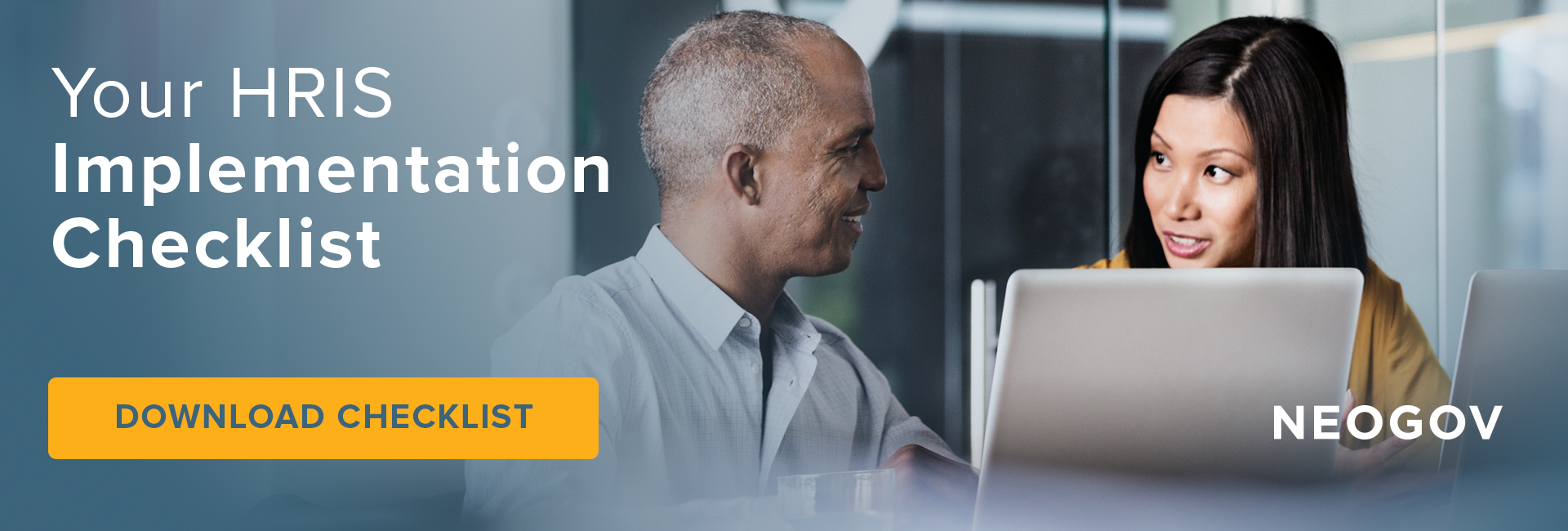Discover the key phases of implementing new HRIS and payroll systems at your public sector organization.
Article Highlights
- What to expect while implementing your new software solution
- How to prepare an effective HRIS implementation project plan
- Review our FREE HRIS implementation checklist
After diligent research, you’ve found the perfect HRIS for your public sector agency – but the hard work isn’t over quite yet. Now, it’s time to set up your new HRIS system, a process that requires abundant planning, coordination, and communication.
There’s no doubt about it: implementing new HRIS and payroll systems can feel overwhelming. And as a government employee already short on time, you’re undoubtedly wondering how to juggle implementation alongside your other responsibilities.
Fortunately, taking a few minutes to understand and plan your HRIS now will reduce the late nights (and headaches) you experience later.
And we’re here to help. In this article, we’ll discuss the different phases of the HRIS implementation process. Then, you’ll learn how to prepare an effective HRIS project implementation plan to get started on the right foot.
What to Expect During Your HRIS Implementation Process
Below, we discuss what to expect as you begin your implementation process, including your overall timeline and common challenges you may face.
Timeline
Let’s address the most pressing issue first: timing. Plan to give yourself at least a month and a half to complete HRIS implementation, and preferably longer. It’s not uncommon for the whole process to take several months or more from start to finish, particularly for government organizations.
Your implementation timeline will vary according to factors like the specific features of your new HRIS, whether you’re integrating your new solution with existing HR systems, and how much set-up support your software provider offers.
Other facts that can influence your implementation timeline include:
- Your implementation team’s capacity for proactive organization and communication
- Your IT Department’s ability to coordinate with the software company
- The number of employees who need licenses and training
Installation
Since companies offer varied levels of implementation support, clarify how involved the provider will be before you choose your integrated HR and payroll software. Some software providers offer comprehensive installation support, while others provide directions and leave you to figure the rest out independently. Your IT department will also play a critical role in ensuring everything goes smoothly, from granting database access permissions to maintaining cybersecurity protocols.
Data Migration
In the data migration stage, you’ll gather and transfer employee information and other organizational data to your new system. As with installation, some software providers handle data migration for you, while others provide your IT department with instructions to migrate data. Be clear about these expectations from the onset to avoid complications (and implementation timeline delays) at this stage.
Configuration
After you’ve migrated your data to your HRIS and payroll systems, your software provider will configure your HRIS. This includes aligning the HRIS with your organization’s established HR processes (for example, creating approval workflows for PTO requests) and ensuring the system can efficiently handle all employee updates and requests. At this stage, some providers will also integrate your existing software systems with your new HRIS.
Testing
Before your go-live date, you must test the system to ensure it works properly. Testing allows you and your software provider to catch and fix errors before employees rely on the new HRIS to complete critical tasks.
Pretend you are using the system to complete everyday, routine actions. Does everything work as intended? Are requests routed where they need to go, and do you receive notifications when you’re supposed to? Can you access, update, and save employee information? If the answer to any of these questions is “no,” you still have some adjustments to make.
Go-Live & Adoption
After installation, data migration, configuration, and testing, you’re officially ready to go live. Send emails, post fliers, and hold info sessions to ensure all employees know your go-live date and when they can begin using the new system. In addition to sharing your go-live date with employees, provide comprehensive training to make adoption across your agency as seamless as possible.
Common Implementation Challenges
As a public sector agency, one of the biggest challenges you’ll face during HRIS implementation is having limited resources. Constraints on your time make it more difficult to ensure data accuracy, maintain streamlined project management, and train employees on the new system – all of which ultimately influence your time to adoption.
To overcome these common challenges, budget as much time as possible for implementation so you can clean and integrate data sets, coordinate implementation to-dos, and develop training that will meet the needs of your employees.
How to Prepare an Effective HRIS Implementation Project Plan
Preparation is vital to a hassle-free, efficient implementation process. Next, we discuss the key steps to include in your implementation project plan.
(P.S. As you develop your plan, be sure to leverage the expertise of your HRIS software provider. They can provide valuable insights to help you anticipate and troubleshoot obstacles, ensuring a smooth implementation process.)
Identify Your Stakeholders
Identify the key players in your HRIS project implementation, both within and outside your organization. These are people who will be impacted by the project, even if they aren’t directly involved in the logistics of implementation.
Stakeholders include representatives from your chosen HRIS software company, team members from your HR and IT departments, organizational leadership, and all those employees who will ultimately use your software upon adoption.
Build an Implementation Team
After identifying your stakeholders, determine who will be actively involved in moving implementation forward. Ideally, you will invite members from each stakeholder group to join your implementation team. Don’t forget to include employees who are willing to serve as beta testers to ensure the HRIS works as intended.
Outline an Implementation Timeline
Next, outline what needs to happen and when. It’s okay if this timeline changes as you begin actual implementation. This timeline is meant to ensure you have a rough idea of when each phase of HRIS implementation will occur.
Define Your Goals
As you develop your timeline, determine what success looks like in each phase. Defined goals ensure you complete all required tasks and inform when it’s time to move to the next stage of project implementation. For example, one goal might be to test your employee PTO request workflow before going live with your HRIS.
Assign Specific Tasks to Each Implementation Team Member
As you create your implementation timeline and goals, assign specific tasks to each team member. This step ensures everyone knows exactly what’s expected of them and helps clarify implementation responsibilities between your organization and the software provider.
Develop an Onboarding and Training Plan for Your Employees
To make sure all employees know how to use your new HRIS when it goes live, develop a plan to train employees in the new system. You might hold meetings for employees to receive log-in information and ask questions, or create “how to” documents for specific use cases and needs.
Keep Employees Informed About Implementation Progress
As you move through every stage of your HRIS implementation project plan, keep your employees informed about your progress. Be prepared to answer their questions and share when and how employees can use the new HRIS. If you hit any unexpected obstacles that may delay your go-live date, share this information with your employees so they know the updated adoption timeline.
Review Success and Challenges
Once you’ve completed project implementation and your HRIS is officially live, reflect on the success and challenges you faced at each stage. This reflection time is a great way to celebrate your hard work and helps you get started on the right foot the next time you introduce a new software solution to your agency.
Want to make sure you remember everything we discussed? Stay on track with this FREE HRIS Implementation Checklist!
Still Considering HRIS and Payroll Systems for Your Agency?
If you’re still looking for that perfect HRIS, we can help with that, too.
NEOGOV’s HRIS is an integrated HR and payroll software created to meet the unique needs of government agencies. Our HRIS centralizes all your core HR, payroll, benefits, time/attendance data, and workflows in one easy-to-use system, so employees across your agency benefit.
The best part? Our customer support team handles the entire HRIS implementation process for you – including training – to ensure every stage runs smoothly.
If you’re excited to learn more, read all about NEOGOV’s software solutions in our HRIS Learning Center.

